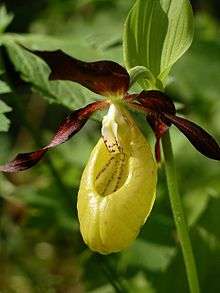Cypripedium calceolus
| Cypripedium calceolus | |
|---|---|
 | |
| Scientific classification | |
| Kingdom: | Plantae |
| (unranked): | Angiosperms |
| (unranked): | Monocots |
| Order: | Asparagales |
| Family: | Orchidaceae |
| Subfamily: | Cypripedioideae |
| Genus: | Cypripedium |
| Species: | C. calceolus |
| Binomial name | |
| Cypripedium calceolus L. | |
| Synonyms[1] | |
| |
Cypripedium calceolus is a lady's-slipper orchid, and the type species of the genus Cypripedium.
It has a widespread distribution from Europe east through Asia from Spain to the Pacific, including almost every country in Europe plus Russia (European Russia, Siberia, and the Russian Far East), northeastern China (Heilongjiang, Jilin, Liaoning, Nei Mongol), Mongolia, Korea and Rebun Island in Japan.[1][2][3] It is typically found in open woodland on moist calcareous soils. In continental Europe it is also found growing in the decomposed humus of semi-shaded woodland cover on limestone. It has declined over much of the European part of its range, and as a result is legally protected in a number of countries.
In Britain, it was formerly a reasonably widespread plant across northern England, particularly the limestone area of the Yorkshire Dales.[4] By the late 20th century it had declined to just a single plant in one location in the dales.[5] While the virtual extinction of the lady's-slipper orchid from its historical range in Britain is often blamed on uprooting by gardeners and botanists, it is also the case that its preferred habitat shrank markedly with human clearance of woodland from the limestone landscape, and the grazing of sheep will have finished it off.[6] A reintroduction program for the lady’s-slipper orchid is in place,[7][8] and has led to a population of hundreds of plants as of 2003.[9]
The Norwegian municipality of Snåsa has a Cypripedium calceolus in its coat-of-arms.
In Pavel Ivanovich Melnikov's "In the Forests", a znakharka (Russian wise woman) calls this Adam's head, Adam's grass, and Cuckoo's slippers and says it is good for every ill including driving away evil spirits.
Cypripedium calceolus sensu stricto ("in the strict sense") does not occur in North America. The closely related Cypripedium parviflorum and C. pubescens are often still referred to as subspecies or varieties of C. calceolus.

References
- 1 2 Kew World Checklist of Selected Plant Families
- ↑ Altervista Flora Italiana, Yellow Lady's Slipper, Cypripedium calceolus
- ↑ Flora of China, v 25 p 杓兰 shao lan, Cypripedium calceolus
- ↑ Endangered Plants, Jan Čeřovský (1995) ISBN 1-85778-101-5
- ↑ Pardosa lugubris (Walckenaer, 1802) at Grass Wood, North Yorkshire. Spider Recording Scheme News No. 56
- ↑ Britain’s Rare Flowers, Peter Marren (1999) ISBN 0-85661-114-X
- ↑ Lady’s-Slipper Orchid Cypripedium calceolus Species Action Plan Yorkshire Dales National Park Authority
- ↑ Re-Introduction Project - Lady's-Slipper, Conservation in action, Britain's Orchids, A guide to the identification and ecology of the wild orchids of Britain and Ireland, David Lang and Natural England
- ↑ Phillip Cribb (July 2003). "Orchid Research Newsletter No. 42".
External links
-
 Media related to Cypripedium calceolus at Wikimedia Commons
Media related to Cypripedium calceolus at Wikimedia Commons -
 Data related to Cypripedium calceolus at Wikispecies
Data related to Cypripedium calceolus at Wikispecies - Kew Botanica Gardens, Science and Conservation, Cypripedium calceolus (lady's slipper orchid)
- ARKive Lady’s slipper orchid (Cypripedium calceolus)
- NatureGate
- Tela Botanica, Sabot-de-Vénus, Cypripedium calceolus
- Verband Botanischer Garten, Cypripedium calceolus (Frauenschuh)
- Au Jardin, Le Monde, Sabot de Vénus
